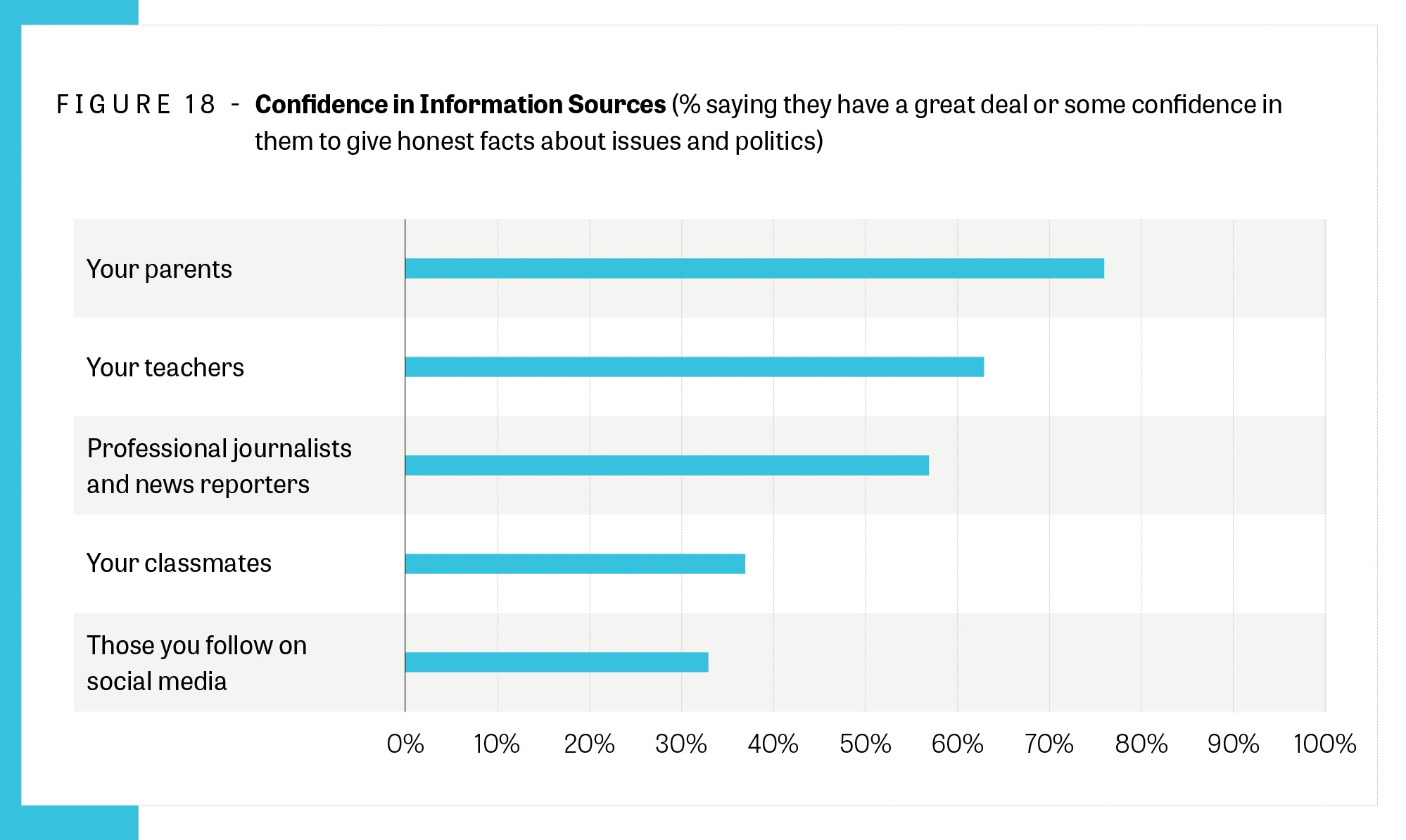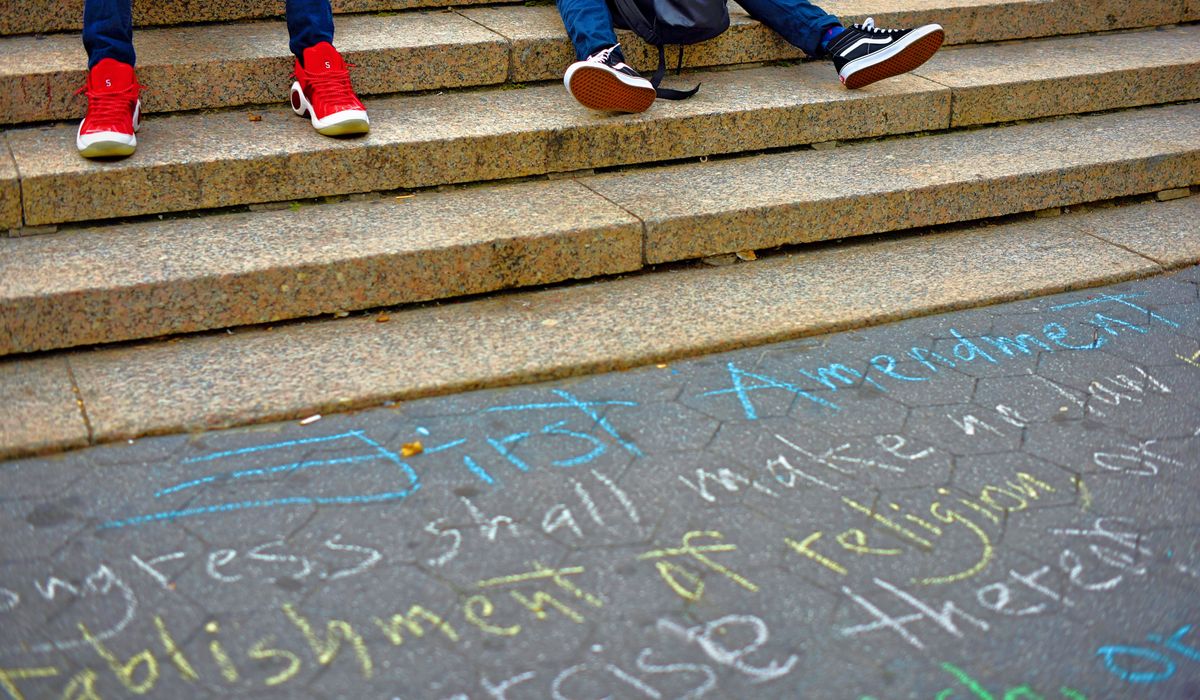A Knight Free Expression Research (KFX) Series Report
EXECUTIVE SUMMARY
The Future of the First Amendment project has been surveying high school student and teacher attitudes about free speech and the news media for eighteen years. The 2022 survey is the eighth running of this national high school survey and provides an important look into the views and attitudes toward speech among young people in the wake of the pandemic and the social justice movement.
- American high school students and their teachers continue to show support for the rights and guarantees of the First Amendment. They overwhelmingly agree that people should be allowed to express unpopular opinions, a finding that has been consistent for nearly two decades. Support for speech drops below half when opinions are “offensive” or “threatening.” Still, a majority say it’s more important to protect people’s ability to say what they want versus protecting people from hearing things that might offend them.
- Students show lukewarm support for prohibiting government censorship of news and social media. Only 57% say news organizations should be able to publish without government censorship, while 59% say the same for people posting on social media.
- A slight majority of high school students (56%) are comfortable voicing disagreement with their teachers and other students in the classroom––and students say they are more comfortable doing that in person versus in a virtual classroom. Students and teachers disagree sharply on the authority of school officials to discipline students who make offensive social media posts outside of school.
- While 83% of students agree on the importance of speech rights for democracy, they make important distinctions as to what constitutes a legitimate expression of First Amendment rights. Most (78%) view the summer 2020 protests around racial injustice as a legitimate expression of rights. Two-thirds also regard the protests against certifying the 2020 presidential election as legitimate. However, one-third think that entering the Capitol on January 6 to disrupt the certification of the election and the spreading of misinformation about COVID-19 or the election are legitimate.
- In every survey we have conducted since 2004, we found that students who have taken classes that include First Amendment content tend to be more supportive of free speech rights than those who have had no such coursework. The 2022 survey once again confirms the connection between First Amendment coursework and support for free speech rights.
- Consistent with our past surveys, gender as well as race and ethnicity are related to the willingness of students to say that the “First Amendment goes too far” in the rights it guarantees. Students in racial minority groups, women and non-binary students are less likely to feel they are protected by the First Amendment than white and male students.
The 2022 Future of the First Amendment study marks the eighth time since 2004 that Knight Foundation has commissioned a national survey of high school students and teachers to explore their attitudes about the First Amendment. As in past years, Dr. Kenneth Dautrich of The Stats Group conducted the study. The 2022 study includes responses from 10,098 high school students and 672 high school teachers, repeating many of the core questions that have been asked in the past so that we can identify trends in student and teacher opinions over time.
The study also asked select questions from other surveys in the Knight Free Expression Research Series conducted by Ipsos of 1,000 college students (College Student Views on Free Expression and Campus Speech 2022) and 4,000 American adults (Free Expression in America Post-2020) in order to compare the sentiments of these groups to those of high school students.
This report on the findings from the 2022 study is organized into three sections and an appendix:
Section I:
- Section I presents findings on important trends in student and teacher opinions on free speech and First Amendment issues.
Section II:
- Section II discusses findings from new free speech topic areas that were explored in the 2022 survey.
Section III:
- Section III looks at both trends and new topics related to the consumption, attitudes and trust in news and information.
Appendix A:
- Appendix A provides an overview of the methodology used to conduct the surveys.
Section I
Trends in Attitudes About Free Speech and the First Amendment
In this section, we present findings on important trends in student and teacher opinions on free speech and First Amendment issues. The broad, general support for people to express unpopular opinions has remained strong since we began surveying students in 2004. Generally, support wanes when the type and circumstances of the speech are specified.
Over the past eighteen years, the percentage of students who say that the First Amendment goes too far, suggesting weaker support for the First Amendment, has varied. It was at its highest in 2006 when 45% said it went too far and at a low point in 2011–14 when 24% said that. Over the past four years, there has been a slight uptick in the number of students and teachers who believe that the First Amendment goes too far in the rights it guarantees. There has also been a steady uptick in the percentage of students answering “don’t know,” from 17% in 2016 to 23% in 2022.
While nearly half of students (47%) disagree that the First Amendment “goes too far in its rights and guarantees,” the 30% of students who agree represents a 4-point increase since the report was last fielded in 2018. Despite the recent shift, an even larger percentage of students said the First Amendment goes too far 15 years ago.
Compared to students, fewer teachers (22%) say the First Amendment goes too far in the rights it guarantees, while 72% disagree. Only 6% say they “don’t know.” However, similar to the student trend, more teachers now say the First Amendment goes too far than did four years ago (14%).

High schoolers (89%) overwhelmingly agree that people should be allowed to express unpopular opinions. High school students and their teachers have remained stable on this for over a decade. When compared to Knight-Ipsos 2022 survey data, high schooler support is similar to college students (90%), high school teachers (94%) and American adults (88%).
However, there are some significant differences between these groups on specific aspects of free speech. Students are more supportive of free speech than teachers when speech is “threatening,” but less supportive when it is “offensive.”

In a follow up question, respondents were asked to choose which is more important: “protecting people’s ability to say what they want” versus “protecting people from hearing things that offend them”. A majority of students (62%) say it’s more important to protect people’s ability to say what they want versus protecting people from hearing things that might offend them. Only 15% of students say that protecting people from hearing things that might offend them is more important. Teachers are even more likely to think protecting speech (78%) is more important than protection from being offended (10%).
While fairly stable from 2004 through 2018, high school student support for allowing musicians to sing songs with offensive lyrics has dropped over the past four years (from 66% to 56%), trailing teachers (74%). It also lags behind support from college students (76%) and the general public (75%) as seen in Knight-Ipsos survey data. Student support for this right is now at an all-time low since the survey began eighteen years ago, when 70% supported the right of musicians to use offensive lyrics in their songs.

Males (68%) and white students (68%) are more likely to agree that musicians should be able to sing songs with offensive lyrics than are females (49%), gender non-binary students (48%), African Americans (46%), Native Americans (49%), Hispanics (48%) and Asian Americans (44%).
High school students (20%) are less supportive of the right to burn a flag as a political statement than teachers (38%), as well as college students (38%) and American adults (31%), as captured from the 2022 Knight-Ipsos survey. Still, high school student support for this right is now higher than at any point since 2004.

Only 57% of students say that news organizations should not be subject to government censorship. Student support for people posting on social media without government censorship has fallen slightly, from 66% to 59% since 2016. Teachers are more likely than students to reject government censorship of the media by a wide margin.

White and male students continue to show more support for First Amendment principles on the questions in our survey, compared to minority, female and gender non-binary students. White students (25%) are less likely to think the First Amendment goes too far in the rights it guarantees than African American (40%), Native American (39%), Hispanic (36%) and Asian American (31%) students. These differences remained about the same over the past four years.

Male students (34%) are significantly more likely than females (20%) and gender non-binary students (21%) to agree that people should be allowed to say whatever they want in public even if it could be seen as threatening to others. Men (51%) are also far more likely than women (34%) and non-binary students (28%) to agree that people should be allowed to post whatever they want on social media even if it is offensive.

Male (62%) and white students (60%) are somewhat more likely than females (54%), gender nonbinary students (57%), African Americans (57%), Native Americans (50%), Hispanics (54%) and Asian Americans (56%) to agree that government shouldn’t be able to censor news organizations. Male (68%) and white students (69%) are more likely than females (60%), gender non-binary students (50%), Africans Americans (46%), Native Americans, Hispanics (54%) and Asian Americans (52%) to say it is more important to protect free speech rights than it is to protect people from being offended by someone’s speech.
Students and teachers continue to disagree sharply on the authority of school officials to censor school newspapers and discipline students who make offensive social media posts outside of school. High school students (60%), like college students (60%) and American adults (57%) in the 2022 Knight-Ipsos survey, agree that students should be allowed to express their opinions about teachers and school administrators on social media without worrying about being punished by the schools for what they say. Only 38% of teachers, however, agree with this.

High school students and teachers also continue to hold very different opinions about the right of students to report on controversial issues in student newspapers without the approval of the school. In the new survey, 59% of students agree with this compared to only 39% of teachers.

In every survey we have conducted since 2004, we found that students who have taken classes that include First Amendment content tend to be more supportive of free speech rights than those who have had no such coursework. Also, as in past surveys, about 6 in 10 (63%) of students in 2022 say they have taken at least one class with First Amendment content.1

That completes our review of the trends in high school student and teacher opinion regarding the First Amendment and free speech. We find that overall support, among students and teachers, for the right of people to express unpopular opinions remains very high. When speech becomes offensive or threatening, those agreeing that the speech should be allowed declines quite a bit. We also detect a new trend toward less student support for musicians to sings songs with offensive lyrics. Consistent with our past surveys, gender and race/ethnicity are related to the willingness of students to say that the “First Amendment goes too far.” On many measures of support for free speech in our survey, those in minority groups are less likely to endorse the free speech position. Finally, students and teachers continue to disagree sharply on the authority of school officials to censor school newspapers and discipline students who make offensive social media posts outside of school.
Section II
Questions New to the 2022 Survey on Free Speech and the First Amendment
This section discusses findings from new free speech topic areas that were explored in the 2022 survey. These new areas include perceptions about whether First Amendment rights apply to one personally, the importance of rights and safety, perceptions of the legitimacy of recent expressions of speech, comfort in voicing disagreement in the classroom and how easy it is for different groups to express themselves.
While a majority of high school students (62%) think the First Amendment protects them personally, college students (82%), teachers (75%) and the general public (84%) are all more likely to see the relevance of the First Amendment to their lives. White students (69%) are more likely than Hispanics (58%), Asian Americans (57%) and Native Americans (56%) to feel that the First Amendment protects them; and significantly more likely than African American students (44%). Male students (67%) are more likely than female (61%) and non-binary students (51%) to feel that the First Amendment protects them.

Strong majorities of students say that the following are very important in our democracy: citizens’ free speech rights (83%), keeping protests from becoming violent (79%), preventing people from inciting violence (76%), preventing the spread of false information (76%), an inclusive society that is welcoming to diverse groups (74%) and protecting the ability of different groups to be heard (75%). Smaller majorities of students feel that creating a robust exchange of ideas and views in society (66%) and allowing people to criticize government and elected officials (62%) are very important.
It is interesting to note that college students and high school students hold similar opinions on the importance of these items to our democracy. It’s also noteworthy that teachers rate all these items as even more important than do students and American adults.
Women students are much more likely than men to say that preventing violence (83%), allowing all groups to be heard (80%) and promoting inclusion and diversity (80%) are important; while men (68%) are much more likely than women (58%) to say that allowing criticism of government is important.

Students make important distinctions in the legitimacy of recent expressions of First Amendment rights: most (78%) view the summer 2020 protests around racial injustice as a legitimate expression of rights. Two-thirds also regard the protests against certifying the 2020 presidential election as legitimate. However, only one-third think that entering the Capitol on January 6 to disrupt the election certification and the spreading of misinformation about COVID-19 or the election are legitimate.

Women (83%) and non-binary students (83%), more than men (73%), view the summer 2020 racial justice protests to be legitimate, as do Asian Americans (88%) and African Americans (89%) more than white students (77%). Native American (48%), African American (40%) and Hispanic students (38%) are more likely than non-minority students (29%) to regard entering the Capitol on January 6 to disrupt the certification of the election to be legitimate. African American (71%), Asian American (68%) and Hispanic students (63%) are more likely than non-minority students (52%) to think that kneeling during the national anthem is legitimate.
A majority of high school students (56%) are comfortable voicing disagreement with their teachers and other students in the classroom. Interestingly, high schoolers are more comfortable voicing disagreement in an in-person classroom (56%) than they are in a virtual classroom (44%).
Teachers were asked how comfortable they are disagreeing with their students. In the classroom, 71% report being comfortable doing this (compared to 56% of students who are comfortable disagreeing with teachers). When it comes to the virtual classroom, however, far fewer teachers (47%) are comfortable disagreeing with students.
Male students (62%, 50%) express higher levels of comfort in disagreeing with their teachers and fellow students, both in class and online, than female (53%, 40%) and non-binary students (46%, 38%). There were no significant differences on this question based on race/ethnicity.

Perceptions vary widely on how easy or difficult it is for different groups to use their free speech rights. Most high school students (75%) believe it is easy for wealthy people to use their free speech rights. Teachers (79%), American adults (71%) and college students (64%) agree that wealthy people have the easiest time doing this.
Majorities of high school students say that White Americans (68%) have an easy time using their rights. Fewer college students (55%) and adults (50%) say it’s easy for white students to do this.
About 6 in 10 high school students and teachers feel that it is easy for men to use their speech rights. However, less than half of college students (45%) and American adults (43%) think it is easy for men to do this.
For all others groups, less than half of high school students, college students and adults say it is easy for those groups to use their speech rights. A majority of teachers say it is easy for liberals (57%) and “people like me” (51%) to use their speech rights. Beyond those groups, less than half of teachers say that it is not easy for those groups to use their free speech rights.

That completes a review of the questions on free speech that were new to the 2022 survey. In them we find that while a majority of high school students feel that the First Amendment protects them personally, they are far less likely to feel the protection of these rights than are college students, teachers and adults in America. Further, racial minorities, women and gender non-binary students are even less likely to feel they are protected by the First Amendment. We also conclude that students make important distinctions in the legitimacy of recent expressions of First Amendment rights: most view the 2020 summer protests around racial injustice as a legitimate expression of rights and most regard the protests against certifying the 2020 presidential election as legitimate. However, only one-third think that entering the Capitol on January 6 to disrupt the certification of the election and the spreading of misinformation about COVID-19 or the election are legitimate.
Section III
Consumption of and Attitudes Toward the News
This section looks at both trends and new topics related to the consumption, attitudes and trust in news and information. Use of traditional news sources has dropped considerably; and while use of online sources is high, it has also dropped in the past few years. When it comes to social media, high school students are more active than others, including college students.
High school student use of the news continues to drop. The decline in student use of local TV news and 24-hour cable TV news is dramatic. In 2016, 67% reported using local TV news often or sometimes. Today, 39% report that level of use. Use of cable TV news was cut by more than half (57% to 27%) during that same six-year period.
Online news sources continue to dominate the ways in which high school students get news. Today, 83% of students use a mobile device often or sometimes (down from 88% in 2016); 64% use a messaging app (the only source experiencing an uptick since its 55% in 2016); 73% use social media (down from 78%); and 66% use videos online (unchanged since 2016).
Unlike students, teachers’ use of online news sources has increased over the past six years (with the exception of online videos). Teachers, like students, have also significantly reduced their use of local TV and cable TV news.

African American students consistently report higher levels of news consumption across a variety of sources than all other racial groups, which is similar to the findings from past studies. For example, 49% of African American students use local TV news at least sometimes (compared to 37% of other racial groups); 38% use cable TV news (compared to 25% of others); 85% use a mobile device (compared to 71%); 78% use online videos (compared to 65%); 84% use social media (compared to 71%); 76% use a messaging app (compared to 62%).
High school students are more proactive than both teachers and college students in using social media: they are more likely to share or repost news stories on social media, more likely to block and defriend, more likely to flag content that they feel violates a platform’s policy. The extent to which high school students engage in sharing/reposting stories and commenting on stories has declined over the past six years.

More than three-quarters of high school students are confident that their parents give them the honest facts about issues and politics. About 6 in 10 are confident that their teachers (63%) and journalists/news reporters (57%) give them the honest facts. Far fewer are confident in their classmates (37%) and those they follow on social media (33%).

Asian American students express higher levels of confidence in both journalists (69%) and teachers (74%) to give them honest facts than do students in all the other racial groups; they also have lower levels of confidence in their parents (69%) than those in other groups. Gender non-binary students also have lower confidence levels in their parents (53%) than males (79%) and females (76%).
High school students are concerned about the level of civility on social media: the vast majority (70%) agree that it’s too easy for people to say things anonymously, about half are afraid of being attacked by someone who disagrees with them (56%), and a minority (38%) feel that dialogue is usually civil. Female students (77%) voice a higher level of concern than male (65%) and non-binary students (60%) on it being too easy to say things anonymously on social media.

Fewer than half of students (48%) and teachers (43%) believe that the news is balanced. Among students, 35% say news is biased in favor of Democrats and 17% say it favors Republicans. Among teachers, 44% say the news is biased in favor of Democrats and 12% say it favors Republicans.

White students (42%) and male students (40%) are much more likely to perceive a news bias favoring Democrats.
Conclusion
The 2022 Future of the First Amendment survey confirms many of the findings from past surveys, identifies some new trends in student and teacher opinion and sheds light on some new issues related to the First Amendment and free speech rights.
On the trends, overall support among high school students for the right of people to express unpopular opinions remains very high. But when speech is characterized as offensive or threatening, those agreeing that the speech should be allowed drops off substantially. Support for musicians to sings songs with offensive lyrics dropped significantly over the past four years. Consistent with our past surveys, gender, race and ethnicity are related to strength of support for the First Amendment and speech principles more broadly. Students and teachers continue to disagree sharply on the authority of school officials to censor school newspapers and discipline students who make offensive social media posts outside of school.
On the new findings, a majority of high school students feel that the First Amendment protects them personally, but they are far less likely to feel the protection of these rights than are college students, teachers and adults in America. Further, racial minorities, women and non-binary students are even less likely to feel they are protected by the First Amendment. Students make important distinctions in the legitimacy of recent expressions of First Amendment rights: most view the summer 2020 protests around racial injustice as a legitimate expression of rights, as most also regard the protests against certifying the 2020 presidential election as legitimate. However, only one-third think that entering the Capitol on January 6 to disrupt the certification of the election and the spreading of misinformation about COVID-19 or the election are legitimate.
Finally, this survey documents the precipitous decline in student use of traditional news sources and the dominance of online outlets for getting news. It also shows how much more proactive high school students are than their teachers, older Americans and even college students in their use of social media.
Appendix A: Survey Methodology
This project was designed by Dr. Kenneth Dautrich of the Stats Group, who is also responsible for the survey analysis and writing of this report.
This is the eighth in a series of surveys of high school students and teachers sponsored by the John S. and James L. Knight Foundation. Prior surveys were conducted in 2004, 2006, 2007, 2011, 2014, 2016 and 2018. The initial survey sampled more than 300 high schools in the United States. For the 2006, 2007, 2011, 2014, 2016, 2018 and 2022 surveys, schools were randomly sampled from a comprehensive list of U.S. schools.
The overall design for conducting this project featured a multistage cluster sampling methodology. Employing this technique produced a scientific and thus generalizable survey of students and teachers in public and private high schools in the United States. This technique involved drawing a representative national sample of 50 high schools in the United States. Survey questions were vetted with high school educators and those familiar with media literacy.
For each of these 50 schools, a phone call was placed to the principal, asking if the school would be willing to participate in the project. Thirty-one principals agreed—a high response rate of 62%, thus enhancing our confidence that the sample is a highly representative one. The principals coordinated the administration of surveys to all students and teachers in their schools.
The field period for the survey was from November 2021 through February 2022. In total, 10,098 students and 672 teachers completed the questionnaires. For the student survey, the results are accurate to within plus or minus 1 percentage point at the 95% level of confidence. For teachers, the results are accurate to within plus or minus 3.7 percentage points.
In the News
Need to Know: May 25, 2022 – American Press Institute
High school students support ‘unpopular’ but not ‘offensive’ free speech, survey finds
Knight Free Expression Research Series
Our First Amendment rights to free expression play a vital role in maintaining a healthy and participatory democracy. We see speech and press freedom as central to our mission to foster informed and engaged communities. It’s critical for policymakers and educators to understand how Americans view free expression rights and related issues. This is especially […]
College Student Views on Free Expression and Campus Speech 2022
A Look at Key Trends in Student Speech Views Since 2016 College campuses have long been places where the limits of free expression are debated and tested.
Free Expression in America Post-2020
A Knight-Ipsos study from the Knight Free Expression Research Series A Landmark Survey of Americans’ Views on Speech Rights







